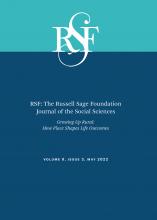Research Article
Open Access
“Turning Their Back on Kids”: Inclusions, Exclusions, and the Contradictions of Schooling in Gentrifying Rural Communities
Jennifer Sherman, Kai A. Schafft
RSF: The Russell Sage Foundation Journal of the Social Sciences May 2022, 8 (3) 150-170; DOI: https://doi.org/10.7758/RSF.2022.8.3.06
Jennifer Sherman
aProfessor of sociology at Washington State University, United States

REFERENCES
- ↵
- Albrecht, Don E
- ↵
- Banse, Tom
- ↵
- Berliner, Uri
- ↵
- Bourdieu, Pierre
- ↵
- Bowlin, Nick
- ↵
- Brown, David L., and
- Nina Glasgow
- ↵
- Brown, David L., and
- Kai A. Schafft
- ↵
- Brown-Saracino, Japonica
- ↵
- Budge, Kathleen
- ↵
- Butler, Rose, and
- Kristy Muir
- ↵
- ↵
- ↵
- Carr, Patrick J., and
- Maria J. Kefalas
- ↵
- Cobb, Robert A.,
- Walter G. McIntire, and
- Phillip A. Pratt
- ↵
- Coladarci, Theodore
- ↵
- Cooper, Marianne
- ↵
- Corbett, Michael
- ↵
- Corbett, Michael
- ↵
- Corbett, Michael
- ↵
- Drescher, Jessica,
- Anne Podolsky,
- Sean F. Reardon, and
- Gabrielle Torrance
- ↵
- Duncan, Cynthia M
- ↵
- ↵
- Fitchen, Janet M
- ↵
- Fitchen, Janet M
- ↵
- Flora, Cornelia Butler, and
- Jan L. Flora
- ↵
- Gerarld, Danette, and
- Kati Haycock
- ↵
- Gkartzios, Menelaos, and
- Ann C. Ziebarth
- ↵
- ↵
- Golding, Shaun A
- ↵
- ↵
- Groenke, Susan L., and
- Jan Nespor
- ↵
- Halfacree, Keith H
- ↵
- Hamilton, Lawrence C.,
- Leslie R. Hamilton,
- Cynthia M. Duncan, and
- Chris R. Colocousis
- ↵
- ↵
- Howarth, William
- ↵
- Howley, Craig
- ↵
- Jencks, Christopher,
- Susan Bartlett,
- Mary Corcoran,
- James Crouse,
- David Eaglesfield,
- Gregory Jackson,
- Kent McClelland,
- Peter Mueser,
- Michael Olneck,
- Joseph Schwartz,
- Sherry Ward, and
- Jill Williams
- ↵
- Johnson, Kenneth, and
- Daniel T. Lichter
- ↵
- Kim, Kwang-Koo,
- David W. Marcouiller, and
- Steven C. Deller
- ↵
- ↵
- Krannich, Richard S., and
- Peggy Petrzelka
- ↵
- Lamont, Michèle, and
- Marcel Fournier
- ↵
- Lareau, Annette
- ↵
- Lareau, Annette, and
- Jessica McCrory Calarco
- ↵
- ↵
- ↵
- ↵
- Lyson, Thomas A
- ↵
- ↵
- Mette, Ian M.,
- Catharine Biddle,
- Sarah V. Mackenzie, and
- Kathy Harris-Smedberg
- ↵
- Miller, Emily E. N., and
- Kathryn Edin
- ↵
- Miller, Portia,
- Elizabeth Votruba-Drzal, and
- Rebecca L. Coley
- ↵
- Minnesota Population Center
- ↵
- ↵
- Nelson, Peter B.,
- Alexander Oberg, and
- Lise Nelson
- ↵
- ↵
- Parcel, Toby L., and
- Mikaela J. Dufur
- ↵
- Petrin, Robert A.,
- Kai A. Schafft, and
- Judith L. Meece
- ↵
- Prins, Esther S., and
- Kai A Schafft
- ↵
- Salamon, Sonya
- ↵
- Schafft, Kai A
- ↵
- ↵
- Schafft, Kai A., and
- Hobart Harmon
- ↵
- Schafft, Kai A.,
- Erin McHenry-Sorber,
- Daniela Hall, and
- Ian Burfoot-Rochford
- ↵
- Schmidt-Wilson, Sarah
- ↵
- Sewell, William H., and
- Robert M. Hauser
- ↵
- Sherman, Jennifer
- ↵
- ↵
- Sherman, Jennifer
- ↵
- ↵
- ↵
- Sherman, Jennifer, and
- Rayna Sage
- ↵
- Shucksmith, Mark
- ↵
- Shucksmith, Mark, and
- Kai A. Schafft
- ↵
- Slack, Tim
- ↵
- Stockdale, Aileen
- ↵
- Thiede, Brian, and
- Tim Slack
- ↵
- ↵
- Tieken, Mara C
- ↵
- Tieken, Mara C
- ↵
- Ulrich-Schad, Jessica D
- ↵
- U.S. Census Bureau (Census Bureau)
- ↵
- U.S. Census Bureau (Census Bureau)
- ↵
- U.S. Census Bureau (Census Bureau)
- ↵
- VanHuevelen, Tom, and
- Katherine Copas
- ↵
- ↵
- Yarwood, Richard
In this issue
“Turning Their Back on Kids”: Inclusions, Exclusions, and the Contradictions of Schooling in Gentrifying Rural Communities
Jennifer Sherman, Kai A. Schafft
RSF: The Russell Sage Foundation Journal of the Social Sciences May 2022, 8 (3) 150-170; DOI: 10.7758/RSF.2022.8.3.06
Jump to section
Related Articles
- No related articles found.
Cited By...
- No citing articles found.





